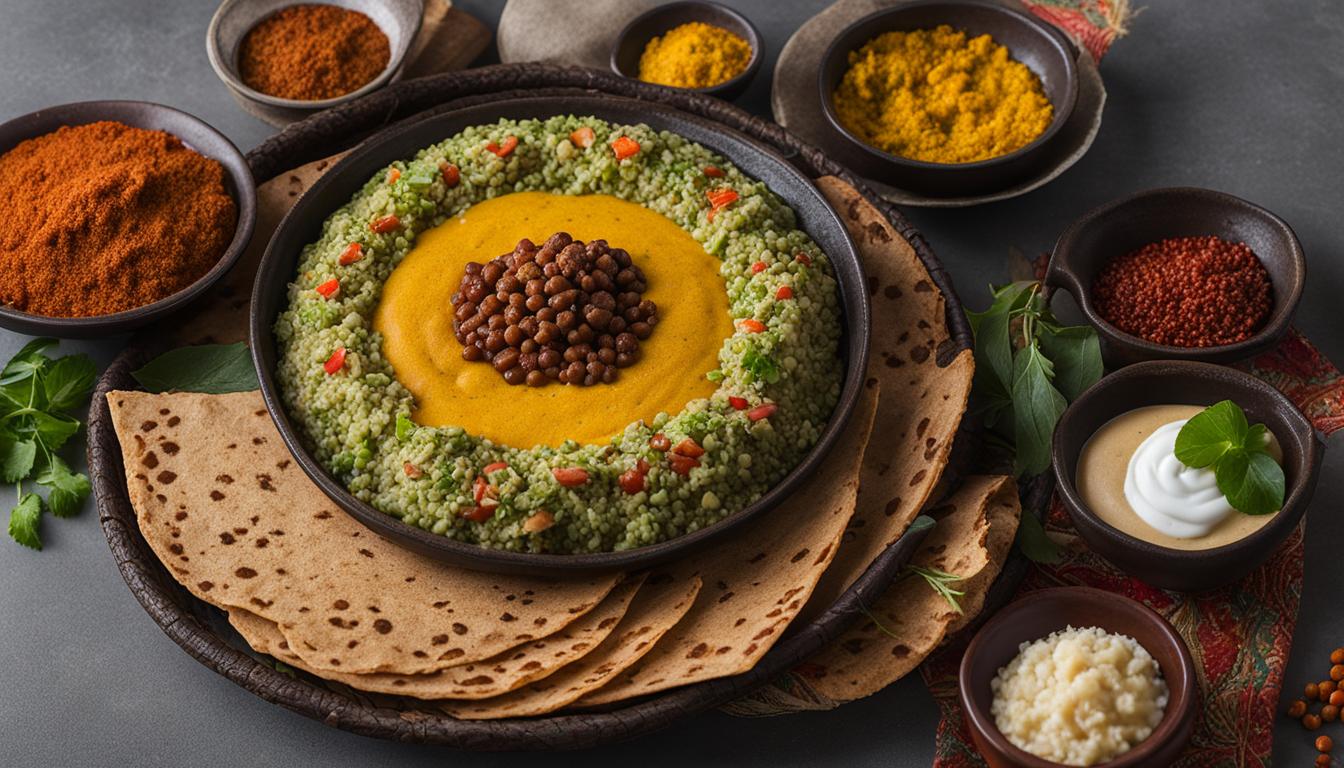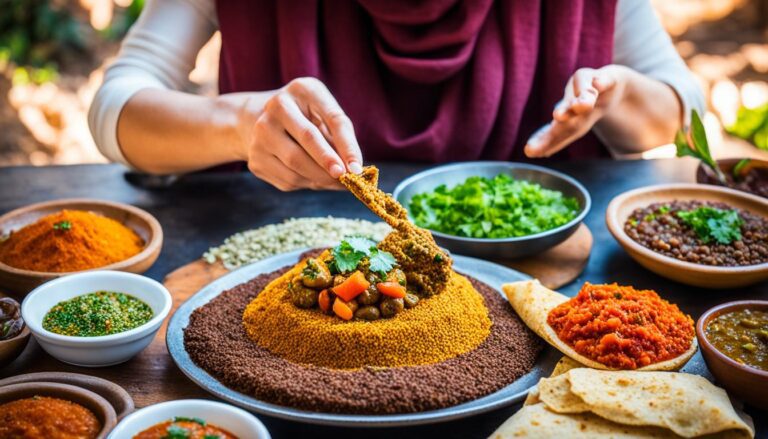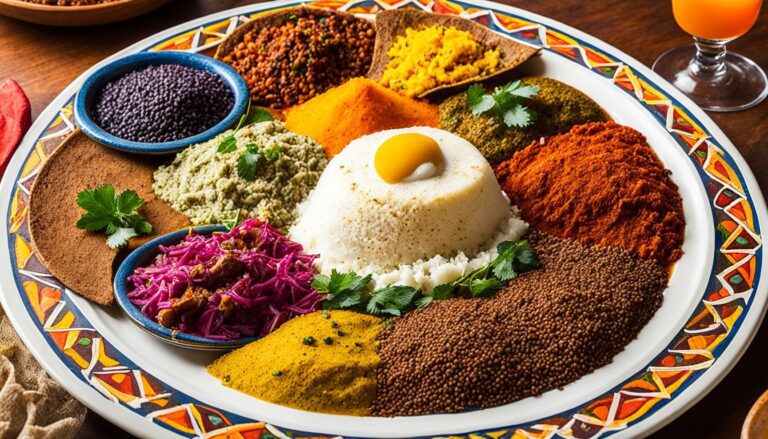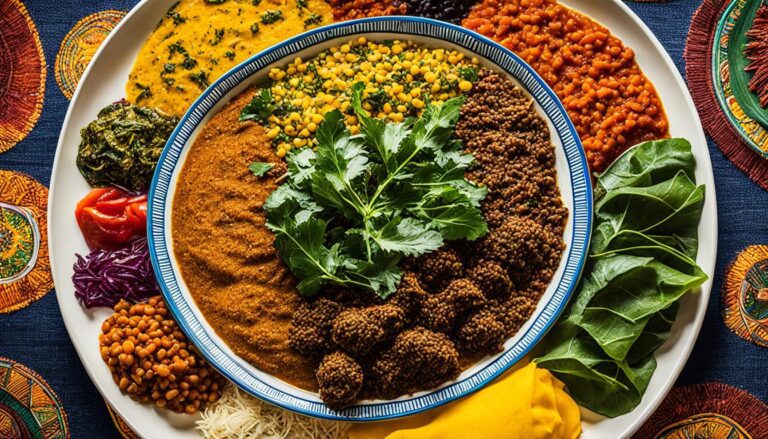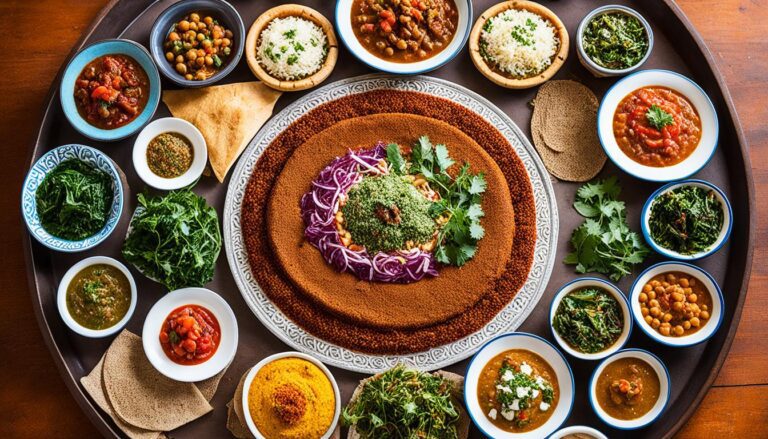What Is Ethiopian Food?
Have you ever wondered what sets Ethiopian food apart from other cuisines? Is it the unique dishes, the rich flavors, or the communal dining experience? Ethiopian cuisine is a culinary treasure that offers a taste of the country’s rich cultural heritage. It’s time to dive into the vibrant flavors of Ethiopia and uncover the secrets behind its distinctive cuisine.
Key Takeaways:
- Ethiopian food is known for its unique dishes and rich flavors.
- The communal dining experience is an integral part of Ethiopian cuisine.
- Spices like berbere and mitmita add depth and complexity to Ethiopian dishes.
- Injera, a spongy bread, serves as the foundation of Ethiopian meals.
- There are a variety of vegetarian and vegan options available in Ethiopian cuisine.
The Foundation of Ethiopian Meals: Injera
Injera is the foundation of Ethiopian meals and plays a central role in Ethiopian cuisine. Made from teff flour, a grain indigenous to Ethiopia, injera is a staple food and a beloved cultural icon. It is not only a delicious and versatile food but also an integral part of communal dining experiences.
The process of making injera begins with grinding teff flour into a fine consistency. Teff flour is known for its distinctive nutty flavor and high nutritional value, making it a healthy choice for bread. After grinding, the teff flour is mixed with water and left to ferment for a period of time, typically overnight. Fermentation is crucial as it creates the characteristic spongy texture and tangy taste of injera.
Once the batter has fermented, it is poured onto a hot skillet or griddle and cooked into a large circular pancake. The result is a thin but resilient bread with a slightly sour taste. The unique texture of injera allows it to absorb the flavors of the dishes it accompanies, making it the perfect vessel for savoring Ethiopian cuisine.
But injera serves a dual purpose beyond being a flavor-enhancing bread. It also acts as a plate and utensil during Ethiopian meals. Dishes are placed directly on top of the injera, creating a colorful and vibrant spread. To eat, one simply tears off a piece of injera and uses it to scoop up the various dishes, combining flavors and textures in each bite.
The Significance of Communal Dining
The communal dining experience is an essential part of Ethiopian culture. Sharing is not only encouraged but expected, making every meal a social occasion. When dining with friends or family, a large circular tray called a gebeta is often used to hold the injera and the assortment of dishes. This style of dining fosters a sense of togetherness and community, creating a warm and inviting atmosphere.
Through injera and communal dining, Ethiopian cuisine not only satisfies our taste buds but also nourishes our souls. It invites us to connect with one another, share delightful flavors, and celebrate the rich culinary heritage of a vibrant nation.
Flavors and Seasonings in Ethiopian Cuisine
Ethiopian cuisine is renowned for its vibrant and robust flavors, thanks to the diverse array of spices and seasonings used in their traditional dishes.
One of the most iconic spice blends in Ethiopian cooking is berbere. Made with a combination of chile peppers, fenugreek, cinnamon, ginger, cardamom, coriander, and other spices, berbere adds a distinctive spiciness and depth of flavor to many Ethiopian dishes. Its complex and aromatic profile enhances the taste of stews, grilled meats, and vegetable dishes.
Mitmita is another integral part of Ethiopian cuisine, offering a kick of heat and complexity to various meat dishes. This dry spice blend typically includes chili peppers, cardamom, cloves, and other aromatic ingredients. Mitmita is often served on the side, allowing diners to customize the level of spiciness according to their preference.
Another staple in Ethiopian cuisine is niter kibbeh, a clarified butter infused with spices like fenugreek, cumin, and turmeric. Niter kibbeh adds depth and richness to dishes, imparting a savory and aromatic note that elevates the overall flavor profile.
These spices and seasonings, berbere, mitmita, and niter kibbeh, play a pivotal role in creating the distinct and tantalizing taste of Ethiopian cuisine. They contribute to the richness, complexity, and depth of flavor that makes Ethiopian dishes truly unique and memorable.
Traditional Ethiopian Dishes
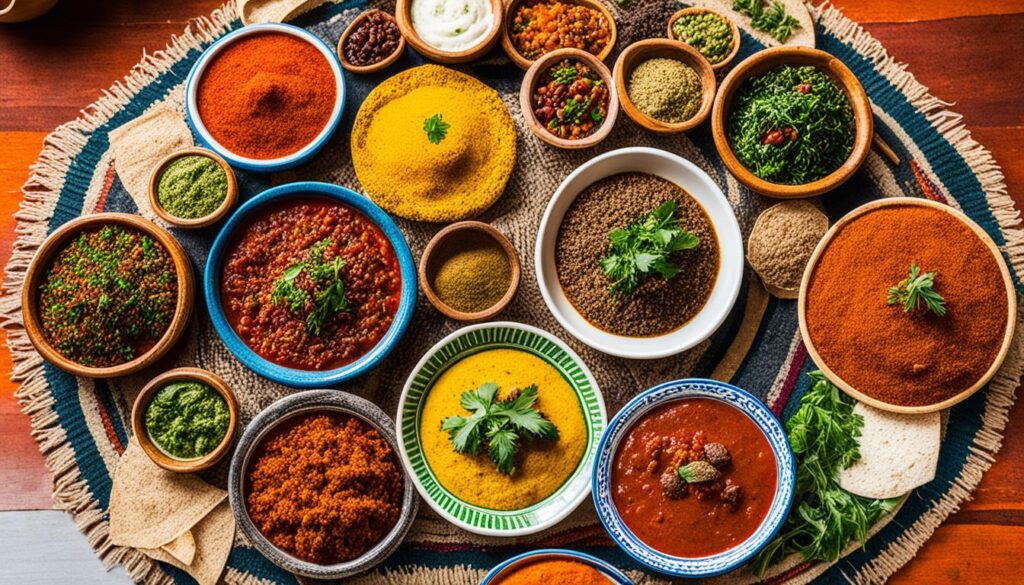
Ethiopian cuisine offers a wide variety of traditional dishes that showcase the unique flavors and ingredients of the country. From savory meats to flavorful stews, Ethiopian dishes are a feast for the senses.
Tibs is a popular Ethiopian dish that features pan-fried beef or lamb seasoned with spices. Served with injera, a spongy bread, tibs is a hearty and satisfying meal that highlights the rich flavors of Ethiopian cuisine.
Shiro wat is another flavorful stew that is often made from legumes or lentils. Packed with spices and served with injera, shiro wat is a vegetarian-friendly option that still captures the bold and aromatic essence of Ethiopian food.
For chicken lovers, doro wat is a must-try dish. This chicken stew is cooked with berbere seasoning, which infuses it with a spicy and aromatic flavor. Served with injera, doro wat is a classic and beloved dish in Ethiopian cuisine.
If you’re looking for a unique and refreshing dish, try injera fit fit. Made from day-old injera soaked with leftover stew, this cold dish has a delightful combination of textures and flavors. It’s a perfect way to use up leftover ingredients while still enjoying the essence of Ethiopian cuisine.
Ethiopian dishes like tibs, shiro wat, doro wat, and injera fit fit are a true representation of the rich and communal dining experience that Ethiopian cuisine offers. The blend of spices, the sharing of food on a large tray, and the spongy injera bread all contribute to the unique and unforgettable flavors of Ethiopian cuisine.
Discover the vibrant and diverse world of Ethiopian food, where every bite is a celebration of culture and taste.
Vegetarian and Vegan Options in Ethiopian Cuisine
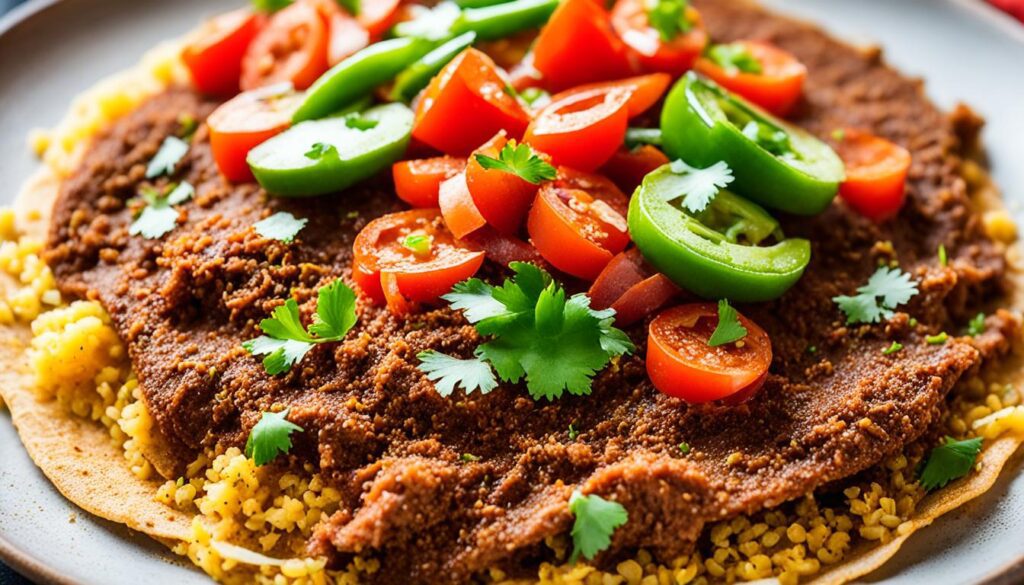
Ethiopian cuisine offers a wide range of delicious and satisfying options for both vegetarians and vegans. Whether you’re following a plant-based diet or simply looking to explore new flavors, Ethiopian food has something for everyone.
Shiro Wat: A Saucy Legume or Lentil Stew
If you’re a vegetarian, one dish you don’t want to miss is shiro wat. This flavorful stew combines ground split pea and chickpeas with a blend of spices and spiced butter. It’s a saucy, comforting dish that pairs perfectly with injera, the traditional Ethiopian bread.
Misir Wat: A Red Lentil Stew
Another staple for vegetarian eaters is misir wat, a dish made from red lentils cooked in a rich and spicy berbere sauce. The lentils become tender and flavorful, creating a hearty and satisfying stew that is often served with injera or rice.
Ethiopian Tomato Salad (Salata)
For a refreshing and tangy option, try Ethiopian tomato salad, also known as salata. This vibrant salad is made with diced tomatoes, onions, chilies, and a drizzle of olive oil. It’s a perfect accompaniment to any Ethiopian meal and adds a burst of freshness to your plate.
Injera Fit Fit: A Burst of Flavors
One of the most unique and delicious vegan dishes in Ethiopian cuisine is injera fit fit. Made from day-old injera soaked in leftover stew, this dish is served cold and bursts with flavors. The combination of the tangy injera and the rich, spiced stew creates a delightful taste experience.
Whether you’re a vegetarian, vegan, or simply looking to try something new, Ethiopian cuisine has a wide variety of options that will satisfy your taste buds. From hearty lentil stews to tangy tomato salads and unique dishes like injera fit fit, the flavors of vegetarian Ethiopian food are sure to impress.
Conclusion
Ethiopian cuisine offers a delightful culinary journey that combines unique flavors, cultural significance, and a communal dining experience. From the spongy injera bread to the richly spiced stews and saucy vegetarian dishes, Ethiopian food is a treasure trove of taste sensations.
As you explore Ethiopian cuisine, you’ll discover a range of dishes that cater to both meat-eaters and vegetarians, showcasing the country’s rich culinary heritage. The use of aromatic spices like berbere and mitmita adds depth and complexity to each bite, making every dish a delight for the senses.
The cultural significance of Ethiopian cuisine shines through its communal dining experience. The use of a large circular tray, known as a gebeta, where everyone shares from a single platter, creates a sense of togetherness and fosters a deeper connection over a meal. It’s a truly immersive and social way of enjoying food.
So, whether you’re trying Ethiopian cuisine for the first time or looking to indulge in its unique flavors, prepare yourself for a culinary adventure that will tantalize your taste buds and leave you craving for more. Experience the cultural richness, embrace the communal dining, and savor the unique flavors of Ethiopian cuisine.

